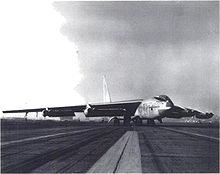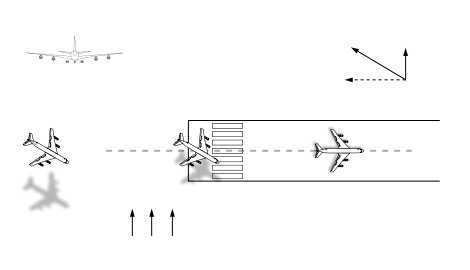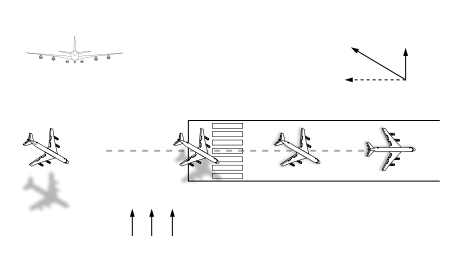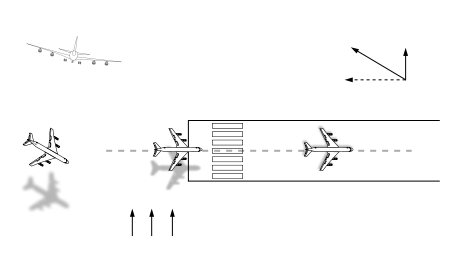- Crosswind landing
-
A crosswind landing is a landing maneuver in which a significant component of the prevailing wind is perpendicular to the runway center line.
Contents
Significance
Aircraft in flight are subject to the direction of the winds in which the aircraft is operating. For example, an aircraft in flight that is pointed directly north along its longitudinal axis will, generally, fly in that northerly direction. However, if there is a west wind in the air in which the aircraft is flying, then the actual trajectory of the aircraft will be slightly to the east of north. If the aircraft was landing on a northbound runway, it would need to compensate for this easterly component of velocity caused by the west crosswind.
In situations where a crosswind is present, the aircraft will adopt a yaw orientation with respect to the runway and will drift laterally as it approaches the runway. These pose significant safety issues when safe operation of the undercarriage requires the body and the velocity of the aircraft to be aligned with the runway at touch down. The landing gear designs of the "pioneer era" 1909 Bleriot XI, and the much later Cold War B-52 strategic jet heavy bomber, were designed and each built with an unusual feature to counteract the problem: with the B-52, all four of its landing gear bogies could be steered, allowing the aircraft to land with the wheels facing the direction of travel even if the nose was not pointed in the same direction. The Bleriot XI had pivoting main gear legs, which passively allowed the main gear wheels to castor together about each of their vertical axes as a unit to allow small-angle crosswind landings, with bungee-cord loaded rigging menbers between the lower ends of the main wheel forks, to bring the wheels back to a "directly-ahead" orientation after touchdown.
To meet these conflicting requirements, three standard procedures are used for executing a safe landing in a cross wind situation. These landings are called the Crab, De-Crab and Sideslip techniques.
If the crosswind landing is not executed safely, the aircraft may experience wingstrike, where a wing hits the runway.
Techniques
The following guidelines are advised by Boeing for a crosswind landing. These guidelines assume steady wind (no gusting). These winds are measured at 10 m (33 feet) tower height for a runway 45 m (148 feet) in width. Basically, there are 3 landing techniques which may be used to correct for cross winds: De-Crab, Crab, and Sideslip.
De-Crab
The objective of this technique is to maintain wings level and the aircraft position near the runway centerline during approach. The nose points into the wind so that the aircraft approaches the runway slightly skewed with respect to the runway centerline (crabbing). This gives the impression of approaching the runway flying sideways, which can be disorienting for the pilot. Position is maintained by balancing the crosswind component, or more accurately the drag force arising from it, with engine thrust. Wings are maintained level throughout the approach. Just before the flare, opposite rudder (downwind rudder) is applied to eliminate the crab, with a simultaneous application of opposite aileron to maintain a wings-level attitude, so that at touch down, the body, velocity vector, and bank angle are all aligned with the runway, and the aircraft is positioned near the center.
Crab
The airplane can land using crab only (zero side slip) up to the landing crosswind guideline speeds.
On dry runways, upon touchdown the airplane tracks towards the upwind edge of the runway while de-crabbing to align with the runway. Immediate upwind aileron is needed to ensure the wings remain level while rudder is needed to track center line. The greater the amount of crab at touchdown, the larger the lateral deviation from the point of touchdown. For this reason, touchdown in a crab only condition is not recommended when landing on a dry runway.
On very slippery runways, landing the airplane using crab only reduces drift towards the downwind side of a touchdown, and may reduce pilot workload since the airplane does not have to be de-crabbed before touchdown. However, proper rudder and upwind aileron must be applied after touchdown to ensure directional control is maintained.
Sideslip
This sideslip crosswind technique is to maintain the aircraft's heading aligned with the runway centerline. The initial phase of the approach is flown using the Crab technique to correct for drift. The aircraft heading is adjusted using rudder and ailerons to align with the runway. This places the aircraft at a constant sideslip angle, which its natural stability will tend to correct. Sufficient rudder and aileron must be applied continuously to maintain the sideslip at this value. The dihedral action of the wings has a tendency to cause the aircraft to roll, so aileron must be applied to check the bank angle.
With a slight residual bank angle, a touchdown is typically accomplished with the upwind main wheels touching down just before the downwind wheels. Excessive control must be avoided because over-banking could cause the engine nacelle or outboard wing flap to contact the runway/ground.
In strong crosswind conditions, it is sometimes necessary to combine the crab technique with the sideslip technique.
References
- Boeing Flight Crew Training Manual
External links
- Crosswind landing test of A380
- Typical crosswind landing of B-52
- FAA - Airplane Flying Handbook FAA 2004
- Private Pilot Practical Test Standards for Airplane FAA August 2002
Takeoff and landing Takeoff Assisted take off · Balanced field takeoff · CATO · CATOBAR · CTOL · JATO · Non-rocket spacelaunch · Rejected takeoff · Rocket launch · STOBAR · STOL · STOVL · V/STOL · VTOHL · VTOL · VTVL · Zero length launch
Landing Belly landing · Crosswind landing · Deadstick landing · Emergency landing · Forced landing · Hard landing · Short-field landing · Splashdown · Touch-and-go landing · Water landing / Ditching
Categories:- Types of landing
Wikimedia Foundation. 2010.




